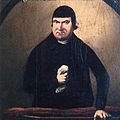History
Shover's Green is on the Wadhurst–Ticehurst road about 2.25 miles (3.6 km) west of the latter. [1] It is also close to Burwash, a village which had a growing congregation of Strict and Particular Baptists in the early 19th century (reflecting the prevalence of Protestant Nonconformity in the county of Sussex as a whole). [2] In November 1815, 24 members of Providence Chapel in Burwash left to found an additional chapel at Shover's Green. [3] [4] [5] Work started in March 1816, [6] and the building was ready in 1817. [7] A Baptist congregation had existed in Wadhurst itself since 1815—it later moved into a former Methodist chapel, and stopped meeting in the 1930s— [8] and Rehoboth Chapel was built in a similar style to the Shover's Green church in 1824. [3] [4] (The chapel at Burwash, now vanished, was also associated with the founding in 1842 of Bethel Chapel at nearby Robertsbridge.) [9] The religious census of Sussex in 1851 recorded that the chapel had 400 sittings, 100 of which were free; and attendances at morning, afternoon and evening services were given as 205, 386 and 87 respectively. The morning and afternoon services were also attended by 47 and 49 Sunday school children respectively. Describing the details of the chapel's founding in the census return, minister James Jones stated: "Before this chapel was erected the congregation assembled for four or five years in a building near this place, belonging to a certain person, but the building being found too small, and not belonging to this congregation, they had the present one erected". [10]
The chapel was renovated in 1876, when the original weatherboarding and timber framing was replaced by brickwork and tiles. [3] [4] As the congregation declined in the late 20th century, the building fell out of religious use, was closed in about 1973 and was converted into a house. [7] Its registration for the solemnisation of marriages was formally cancelled by the General Register Office in March 1980. [11]
Shover's Green Baptist Chapel was designated a Grade II listed building on 12 April 1978. [12]
Architecture
The chapel is a single-storey building with a regular three-bay façade. [3] [12] It has a slate-tiled hipped roof and timber-framed walls with brickwork and tiles in place of the original weatherboarding, still in situ at the nearby Pell Green chapel. [3] The plain façade, facing northeast, has three equally spaced windows with round heads and wooden shutters. The double doorway, between the left and middle windows, has a flat canopy; another door to the right is a later addition, as is a lean-to structure (originally housing a vestry) on the northwest side. [1] [3] [12] In the "nicely furnished interior", a "rather high" pulpit [13] originally stood between two windows in the rear wall. [3] The roof has a bracketed cornice. [12]
This page is based on this
Wikipedia article Text is available under the
CC BY-SA 4.0 license; additional terms may apply.
Images, videos and audio are available under their respective licenses.




